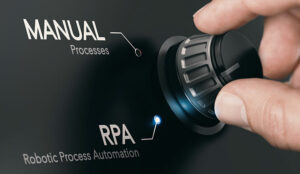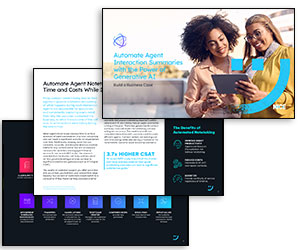What Is RPA? How Is It Used in Contact Centres?
Robotic process automation (RPA) has emerged as a transformative technology within contact centres. RPA in contact centres involves the implementation of software robots to automate repetitive and rule-based tasks, increasing operational efficiency and customer service quality.
These RPA bots can handle a range of activities, including data entry, information retrieval, order processing, and even basic customer enquiries.
By taking on these routine tasks, RPA allows human agents to focus on more complex and value-added interactions, improving customer satisfaction.
Additionally, RPA integration enables seamless data synchronization across different systems, leading to accurate and up-to-date customer information.
How Does RPA Technology Work?
There are two types of RPA: unattended and attended. They work a bit differently, but people often use them together because they are good at different tasks.
- Unattended RPA works on its own without needing people. It’s great for doing lots of tasks that might not be very important individually, but need to be done accurately, quickly, and in large numbers.
- Attended RPA helps with regular computer tasks. It understands what people need and gives them helpful tips and suggestions to make decisions.
The important thing to keep in mind about all RPA technologies is that they are designed to detect a triggered event.
Once this occurs, the software follows a set of instructions to guide information or documents through a real or digital process.
What Is RPA Used for in a Contact Centre?
1. Automated After-Call Work
ACW stands for after call work, where a representative captures why someone got in touch, what was talked about, and plans any needed follow-ups.
The extent of ACW automation can vary based on the enquiry type and handling method. But many basic tasks done by a representative can be done by automation.
These automation tasks include typing, clicking the mouse in a particular part of the screen, choosing from lists, and entering data.
A major benefit of using RPA for after-call work is that you should see a significant reduction in the Average Handling Time of your agents, lowering your staffing requirements.
To learn more about after-call work, read our article: What Is After-Call Work (ACW) and How Can It Be Improved?
2. Follow-Up Communication
After someone talks to the contact centre, automatic surveys or follow-up steps can be sent to customers. These may either help gather data automatically for metrics such as Net Promotor score, or keep customers informed.
Robotic process automation can also send automatic messages to customers to update them about an ongoing question or problem.
This helps keep the customer informed and stops them from needing to contact the centre again, reducing workload for your call centre team.
3. Real-Time Alerts
Supervisors can receive automated notifications regarding any pressing matters that need their quick response.
Using RPA, supervisors can receive automated notifications either on their computer screens or via email regarding any pressing matters that need their quick response.
By incorporating machine learning, notifications can be activated based on patterns, like noticing a rise in employee absenteeism, for instance.
4. Updating Customer Information
Your team will no longer have to handle time-consuming routine tasks, like updating customer addresses or billing details.
This increased efficiency will lead to more tasks being accomplished, giving your team the ability to take on additional assignments and spend more time on the phone with customers.
By combining RPA with speech analytics (and how this technology is rapidly advancing by using machine learning), updating customer information could even be achieved in real time by RPA.
Are you considering implementing speech analytics? If so, read our article: A Checklist for Implementing… Speech Analytics
5. Automating Transactional Conversations
Another part of RPA is the chatbot, crafted to automate specific types of enquiries or ‘agent assist’ – to work with human advisors.
These RPA implementations use AI insights gathered from interactions within the contact centre. The aim is to provide advisors with instant, up-to-date information and recommended strategies, enabling them to provide customer solutions rapidly.
Choosing the Right RPA Solution for Your Contact Centre
RPA tools are great at doing basic tasks accurately and without costing too much. But sometimes, people still need to help them.
Monitoring and constant adjustments to these automations are required to continue to provide both customers and advisors with the support they need.
Some solutions need intricate coding to do difficult tasks. But now, there are RPA tools that don’t need coding. These ‘no-code RPA’ tools mean that the technology is far more affordable for all types of businesses.
Many factors need to be considered when selecting the right RPA for your contact centre:
- User friendliness / ease of use
- Ease of integration within your existing system
- Ability to scale
- Process mapping
- Security
- Analytics
Common Mistakes to Avoid When Implementing RPA
Use RPA for the Right Reasons
Start by identifying the business issue rather than focusing on the technology. The crucial aspect of effectively adopting RPA lies in considering it as a solution to tackle a business problem, rather than just employing the technology itself.
When opportunities arise to automate tasks and streamline processes, aim for some simple wins. Creating an initial proof of concept in the early stages is essential for achieving success.
Fail to Plan, Plan to Fail
Companies will adopt RPA, yet they might not achieve the benefits or ROI as a result of poor pre-planning for these tools.
Plot your ‘quick wins’ and ‘long-term goals’ of using RPA
Map out the process ahead of time, asking if RPA is truly the right solution for your business and which processes would benefit immediately. Plot your ‘quick wins’ and ‘long-term goals’ of using RPA.
Communication With Your Contact Centre Team
When you talk about deploying ‘robots’ in your contact centre, teams tend to worry about job security and the old adage of ‘robots taking over’.
Show your team that the role of RPA in your business is to automate the jobs they hate and that it’s being used to make their lives easier.
Manage Senior Expectations
Whilst RPA can provide real value for businesses, you must remember that it is a significant investment. Manage the expectations of your senior leadership team and ensure that you allow for enough time to see the real benefits that RPA is bringing.
Avoid promising immediate results. With all types of RPA, improvement can take time for some processes and the niche elements of your business could prove a challenge for the automation to overcome. Ensure that extensive testing is done before rolling out your RPA to avoid these issues.
If you are looking for more information on RPA and contact centre automation, you should read these articles next:
- What Is Robotic Process Automation (RPA)? and What Are Some Use Cases?
- An Introduction to… Process Automation Technology
- 23 Key Processes Call Centre Automation Can Simplify
- Recorded Webinar: Simplifying and Automating the Contact Centre
- Interaction Analytics in Contact Centres – An Executive Briefing
Author: Xander Freeman
Reviewed by: Jonty Pearce
Published On: 3rd Nov 2023 - Last modified: 11th Jan 2024
Read more about - Technology, Automation, Robotic Process Automation (RPA)
















